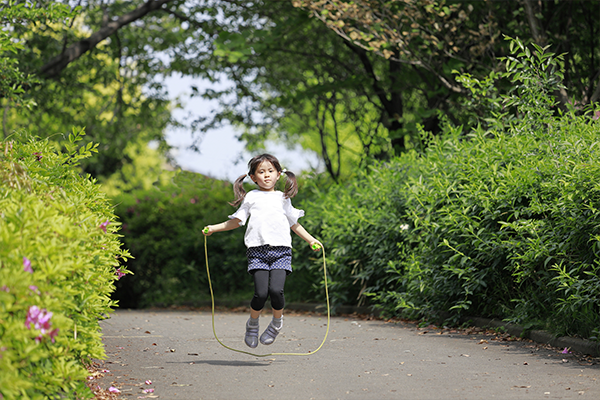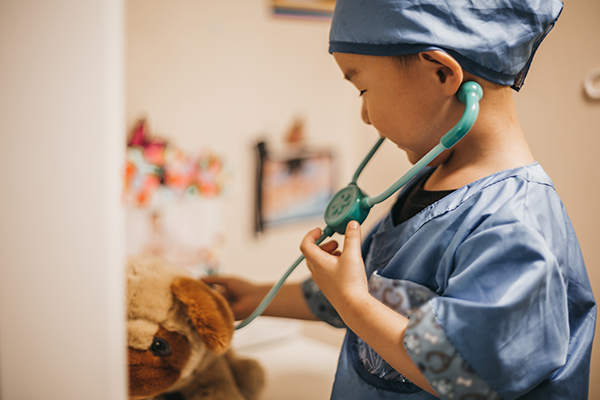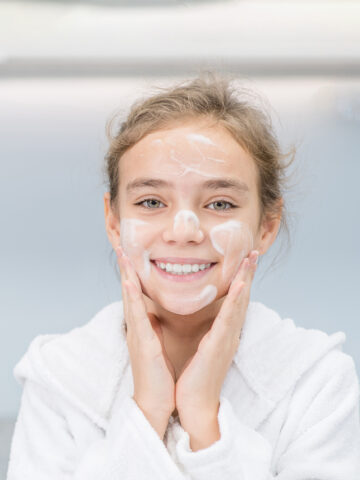Developmental Milestones: 4 to 5 Year Olds (Preschool)
From 4 to 5 years old, your child’s gross motor skills (using their arms and legs to move and play) and their fine motor skills (working on crafts and puzzles) are still developing. Play time becomes increasingly imaginative and is an important part of children’s growth.
Developmental Milestones
Doctors use certain milestones to tell if a child is developing as expected. There’s a wide range of what is considered normal, so some children gain skills earlier or later than others. Children who were born prematurely reach milestones later in life. Always talk with your doctor about your child’s progress, especially if there are concerns.
What can my 4- to 5-year-old child do at this age?
As your child continues to grow, you will notice new and exciting abilities that your child develops. While children may progress at different rates, the following are some of the common milestones children may reach in this age group:
4-year-olds:
- Sing songs
- Skip and hop on one foot
- Catch and throw a ball overhand
- Walk downstairs alone
- Draw a person with three separate body parts
- Build a block tower with 10 blocks
- Understand the difference between fantasy and reality
- Draw a circle and square
- Dress themselves
- Able to fasten large buttons without help
- Pull up a zipper after it is fastened
5-year-olds:
- Jump rope
- Walk backward
- Balance on one foot for at least 5 seconds
- Use scissors
- Begin learning how to tie shoes
- Draw a triangle and diamond
- Draw a person with six body parts
- Know address and phone number
- Recognize and recite the alphabet
- Write first name
- Start to help with chores around the house
- Start to lose their baby teeth
What can my 4- to 5-year-old child say?
Speech development in children is very exciting for parents as they watch their children become social beings that can interact with others. At this age, a child can usually understand that letters and numbers are symbols of real things and ideas, and that they can be used to tell stories and offer information. Most will know the names and gender of family members and other personal information. They often play with words and make up silly words and stories.
4 and 5-year-olds vocabulary is between 1,000 and 2,000 words. Speech at this age should be completely understandable, although there may be some developmental sound errors and stuttering, particularly among boys.
While every child develops speech at his or her own rate, the following are some of the common milestones children may reach in this age group:
4-year-olds:
- May put together four to five words into a sentence
- Will ask questions constantly
- May know one color or more
- Likes to tell stories
- May use some “bad” words (if he or she has heard them spoken repeatedly)
5-year-olds:
- May put together six to eight words into a sentence
- May know four or more colors
- Knows the days of the week and months
- Can name coins and money
- Can understand commands with multiple instructions
- Talks frequently
What does my 4- to 5-year-old child understand?
As a child’s vocabulary increases, so does his/her understanding and awareness of the world around them. Children at this age begin to understand concepts and can compare abstract ideas.
While children may progress at different rates, the following are some of the common milestones children may reach in this age group:
4-year-olds:
- Begins to understand time
- Begins to become less aware of only one’s self and more aware of people around him/her
- May obey parent’s rules, but does not understand right from wrong
- Believes that his or her own thoughts can make things happen
5-year-olds:
- Increased understanding of time
- Curious about real facts about the world
- May compare rules of parents with that of friends
Wellness and Fitness Milestones
By the time kids are 3 to 5 years old, their physical skills, like running, jumping, kicking, and throwing, have come a long way. Now they’ll continue to refine these skills and build on them to learn more complex ones. Take advantage of your child’s natural tendency to be active. Regular physical activity promotes healthy growth and development and learning new skills builds confidence.

How active should my child be at this age?
Kids at this age are learning to hop, skip and jump forward. They are eager to show off how they can balance on one foot, catch a ball or do a somersault. Preschoolers and kindergarteners also might enjoy swimming, playing on a playground, dancing and riding a tricycle or bicycle with training wheels.
Physical activity guidelines recommend that preschoolers and kindergarteners should:
- Be physically active throughout the day
- Move and engage in both active play and structured (adult-led) physical activities
- Do activities such as jumping, hopping and tumbling to strengthen bones and muscles
Should my 4- to 5-year-old child participate in sports?
Many parents look into organized sports to get 4 and 5-year-olds active. The average preschooler has not mastered the basics, such as throwing, catching and taking turns. Even simple rules may be hard for them to understand, as any parent who has watched their child run the wrong way during a game knows.
Starting too young can also be frustrating for kids and may discourage future participation in sports. If you decide to sign your child up for soccer or another team sport, be sure to choose a league that is right for their age and developmental stage. A peewee league that focuses on fun and learning the fundamentals might be great for a child still in preschool.
Family Fitness Tips
Playing together, running in the backyard or using playground equipment at a local park can be fun for the entire family. Other activities to try together, or for a group of preschoolers to enjoy, include:
- Playing games such as “Duck, Duck, Goose” or “Follow the Leader,” then mixing it up with jumping, hopping and walking backward
- Kicking a ball back and forth or into a goal
- Hitting a ball off a T-ball stand
- Playing freeze dance or freeze tag
Kids can be active even when they’re indoors. Designate a safe play area and try some active inside games such as:
- Treasure hunt: Hide “treasures” throughout the house and provide clues to their locations
- Obstacle course: Set up an obstacle course with chairs, boxes, and toys for the kids to go over, under, through and around
- Soft-ball games: Use soft foam balls to play indoor basketball, bowling, soccer or catch. You can even use balloons to play volleyball or catch
How long should my 4- to 5-year-old sleep?
4 to 5-year-olds should be sleeping around 10-12 hours at night. Those who get enough rest may no longer need a daytime nap and can benefit from some quiet time in the afternoon. This is the age where they might be in preschool or in kindergarten. As they give up naps, they may go to bed at night earlier than they did as toddlers.
Check out our guide about Healthy Sleep for Children for more info.
Communication Milestones
Communicating with our kids is one of the most pleasurable and rewarding parts of parenting. Children learn by absorbing information through daily interactions and experiences not only with us, but with other adults, family members, other kids, and the world.
Between the ages of 4 and 5, many kids enter preschool or kindergarten programs, with language skills a key part of learning in the classroom.
How does my 4- to 5-year-old child interact with others?
A very important part of growing up is the ability to interact and socialize with others. This can be a frustrating transition for the parent as children go through different stages, some of which are not always easy to handle. While every child is unique and will develop different personalities, the following are some of the common behavioral traits that may be present in your child:
4-year-olds can:
- Be very independent and may want to do things on his or her own
- Be selfish and do not like to share
- Be moody; mood swings are common in this age group
- Be aggressive during mood swings towards family members
- Have a number of fears
- Have imaginary playmates
- Enjoy exploring the body and may play doctor and nurse
- “Run away” or threaten to do so
- Fight with siblings
- Play with others in groups

5-year-olds can:
- Generally, be more cooperative and responsible than 4-year-olds
- Be eager to please others and make them happy
- Have good manners
- Dress self completely without help
- Get along well with parents
- Enjoy cooking and playing sports
- Become more attached to parent as they enter school
Interacting with Your Child
Kids learn more through interactive conversation and play. Reading books, singing, playing word games and simply talking to kids will increase their vocabulary while providing increased opportunities to develop listening skills. As kids gain language skills, they also develop their conversational abilities. Kids 4 to 5 years old can follow more complex directions and enthusiastically talk about things they do. They can make up stories, listen attentively to stories and retell stories.
Here some ways you can help boost your child’s communication skills:
- Talk about the day’s activities
- Talk with your child about the books you read together
- Talk with your child about the TV programs and videos you watch together
- Keep books, magazines, and other reading material where kids can reach them without help
- Help kids create their own “This Is Me” or “This Is Our Family” album with photographs or mementos
How can I help increase my preschool child’s social ability?
Consider the following as ways to foster your preschool child’s social abilities:
- Offer compliments for good behavior and achievements
- Encourage your child to talk to you and be open with his or her feelings
- Read to your child, sing songs and talk with him or her
- Spend quality time with your child and show him or her new experiences
- Encourage your child to ask questions and explore
- Encourage physical activity with supervision
- Arrange times for your child to be with other children, such as in play groups
- Give your child the chance to make choices, when appropriate
- Use time-out for behavior that is not acceptable
- Encourage your child to express his or her anger in an appropriate manner
- Limit television watching (or other screen time) to 1 to 2 hours a day. Use free time for other more productive activities.
When should I call the doctor?
You should talk to your doctor if you suspect your child has a problem with hearing, language skills or speech clarity. A hearing test may be one of the first steps to find out if your child has a hearing problem.
Communication problems among kids in this age group include:
- Hearing problems
- Trouble following directions
- Trouble asking or answering questions
- Difficulty holding a conversation
- Poor vocabulary growth
- Trouble learning preschool concepts, such as colors and counting
- Stuttering
- Trouble putting sentences together
- Unclear speech
Some kids will outgrow these problems. Others might need speech therapy or further evaluation. This is especially important to assess at a young age because some children that have difficulty with communication may get frustrated, angry and even aggressive because they cannot relay their thoughts and feelings clearly.
Reviewed by Dr. Priya Mody, Pediatric & Adult Medicine, CHOC Primary Care – May 2021
Your child’s health is important at every stage. Visit CHOC Primary Care for pediatric services near you.
Related articles for this age group
A CHOC pediatrician explains the causes of colic in babies, and offers tips to parents for helping their colicky baby.
When siblings Julissa and Joseph were diagnosed with the same rare congenital heart disease, CHOC stepped in to treat them both.
Should teens and preteens be using so many skincare products with fancy ingredients? A pediatric dermatologist answers parents’ questions.
11-year-old Isa had to relearn everything after treatment for FIRES, a rare epilepsy disorder. With help from CHOC rehab, he’s thriving.
A CHOC mental health expert demonstrates five coping tips for parents and caregivers through video, and discusses the importance of self-care.
A CHOC mental health expert helps parents guide their kids and teens through the loss of a family pet, and offers tips for dealing with grief.



















